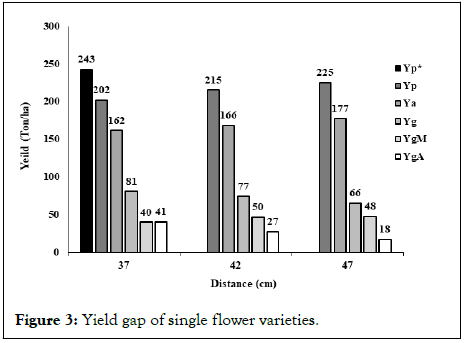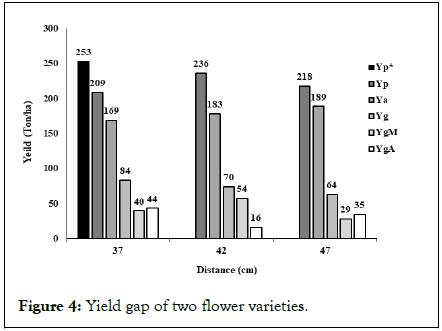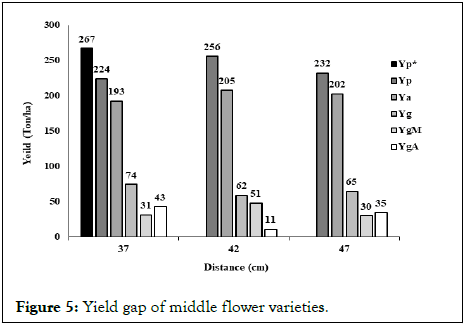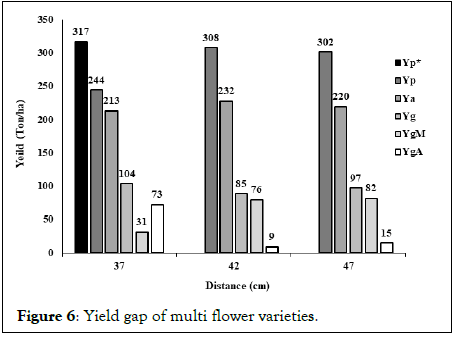Journal of Agricultural Science and Food Research
Open Access
ISSN: 2593-9173
ISSN: 2593-9173
Research Article - (2024)Volume 15, Issue 1
The energy gap of greenhouse cucumbers in this research was investigated due to Iran's large greenhouse cultivation area and the high input energy entrance into these agro-ecosystems. Accordingly, single flower, double flower, middle flower, and multi flower cucumber varieties were cultivated at distances of 37 cm, 42 cm, and 47 cm. The important achievement of this research is making it possible to calculate the energy gap by the yield gap. The turning point is breaking the yield gap into its constituent units, which are caused by management and arrangement. The results showed that up to 104 tons/ha of yield gap was created in the worst case by choosing the wrong variety and inappropriate planting distance, which is equivalent to 82,000 MJ/ha of lost energy in multi-flower varieties. While this amount reduced up to 59 tons/ha in middle flower varieties, which is equivalent to 47,000 MJ/ha of lost energy. Indeed, agro-ecosystems achieved higher output energy by spending specific input energy, which is the basis for sustainable agriculture and reducing the resources lost on a large scale.
Energy gap; Yield gap; Yield gap by management; Yield gap by arrangement; Different varieties of greenhouse cucumber
According to the ministry of agriculture statistics, the total cultivated area of cucumber greenhouses in Iran was estimated to be 6500 hectares. Tehran province has the largest share, with 35% of the total area under cultivation of cucumber greenhouses. Nonetheless, the lowest amount of production per hectare also belongs to this province, with 273 tons/ha of cucumber fruit. Meanwhile, some provinces with fewer areas of cucumber greenhouses such as Yazd with 21% of the cultivation area with the production of 302 tons per hectare have supplied the largest share of the country's yield. As a result, the necessity of investigating the reasons for a lower yield in Tehran becomes more important. The latest data released by the ministry of agriculture reported that 76% of the total cultivated area in Iran has under pressure irrigation. Since close to 100% of total cucumber greenhouses in Iran are under drip irrigation one type of “under pressure irrigation” but Cakir, et al., determined that cucumber yields increased with the increase in the irrigation water amount so that the yield gap caused by lack of water is ruled out in this research. However, Davis et al., emphasized the rule of water limitation in the final yield gap of other irrigation systems and Yaghi, et al., reported the same results in an investigation on the water use efficiency of cucumber [1].
Despite open fields, growth and development factors are under control in the greenhouses. Accordingly, the type of cucumber variety and the spacing between plants are the most important management factors remain which causes this amount of crop loss and Beza, et al., reported the same results by emphasizing the impress of management factors. Pahlavan, et al., used data envelopment analysis to estimate technical efficiency and return to scale for cucumber production greenhouses in Iran. The results showed that the total input energy, total output energy, and energy ratio were 436824 MJ/ha, 128534 MJ/ha, and 0.29, respectively [2]. Moreover, their results determined that close to 30% of the total input energy will be reduced without any change in yield by making all greenhouses more efficient. Therefore, to achieve food safety and prevent the wastage of production resources, it is necessary to identify the most important factors affecting these systems by various methods. One of these methods is the energy gap study, which calculates the lost yield of agro-ecosystems and finally achieves sustainable production by providing appropriate solutions [3].
Case study
The research was conducted in the fall of 2018-2019 in Tehran province, central Iran (Figure 1). Where the cultivated area of cucumber is over 2700 ha (around 35% of the country’s total cultivated area) which is reported in agricultural statistics of the ministry of agriculture. In general, most greenhouses in these areas are dedicated to cucumber cultivation, although 300 ha of the greenhouses produce ornamental plants and cut flowers. Most greenhouse owners in this area experimentally cultivate cucumber plants in 37 cm-47 cm on row distances [4].
Figure 1: The study site (Tehran region in Central Iran).
Sample selection
A statistical sample of all cucumber growers in the study region was interviewed about production practices, the distance between plants, and the final yield of each type of cucumber. The sample size was determined using the Bartlet proportional allocation method, by which a statistical sample of 83 greenhouse cucumber growers was determined as a representative of the whole population (equation 1) [5].

Where:
n=Required sample size.
N=The number of holdings in the target population.
Nh=The number of greenhouses in the hth category.
Sh2=The variance of the greenhouses in the hth category.
D=Permissible error (5% for a 95% confidence interval) that was calculated by equation 2.

Which d represents the sampling precision and z represents the confidence coefficient of 1.95 at the 95% confidence level.
In order to calculate the energy gap of greenhouse cucumbers after defining the statistical population and recording the complete information on the performance of greenhouses according to Figure 2, the yield gap should be calculated in the first step. The energy gap can be obtained in the second step by the calculated yield gap [6]. To calculate the yield gap, its constituent factors must be calculated through the following equations:

In which;
Yp=Yield potential.
m=Number of years.
The yield potential refers to the yield of cucumber in the absence of any stress, including dehydration, living stresses (pests, diseases, and weeds), and lack of food, etc. In this research, data from the research greenhouse section was conducted under highly controlled conditions, and the yield potential was recorded without almost any stresses and tensions [7].

In which;
Yp*=Superior yield potential.
Sup (Yp)=Equivalent to the highest recorded yield potential of cucumber.
The superior yield potential of the product refers to the highest recorded potential yield of cucumber, which is equivalent to the highest yield of a cucumber greenhouse record, and its value is always higher than the potential yield [8].

In which;
Ya=Actual yield.
m=Number of years.
The actual yield is the yield that most greenhouse growers achieve under real growing conditions in a cucumber greenhouse. Its value is often lower than the yield potential because the actual yield is calculated under conditions where all stresses such as nutrient deficiency, thermal, and moisture stresses occur [9].

In which;
Yg=Yield gap.
Yp*=Superior yield potential.
Ya=Actual yield.
The calculation of the yield gap actually refers to the lost yield amount of superior yield potential that the greenhouse farmers could not achieve under normal growing conditions. There are two main reasons that the greenhouse owners could not achieve the desired production volume (Figure 2). The first reason is the inappropriate planting distance, i.e., the yield gap arises from the greenhouse owners' incorrect planting distance, and it can be calculated by equation 7 [10].

In which;
YgA=Yield gap by arrangement.
Yp*=Superior yield potential.
Yp=Yield potential.
The second reason is greenhouse management, i.e., the yield gap is caused by the greenhouse owners’ incorrect management decision and it can be calculated by equation 8.

In which;
YgM=Yield gap by management.
Yp=Yield potential.
Ya =Actual yield.
By calculating the yield gap of management and arrangement, the most important reasons that have the largest share of the total yield gap can be found (Figure 2) [11].

In which;
EG=Energy Gap.
Yg=Yield gap.
For calculating the energy gap, the coefficient of 0.8 was used in Equation 9 to convert the kilogram unit of yield gap to MJ/ha. Finally, by determining the amount of yield gap which is equivalent to kilograms of cucumbers lost per hectare, it is possible to calculate the energy gap.
Figure 2: Constituent factors of yield gap.
Note: Yp*=Yield potential absolute as defined in equation 4.
Yp=Yield potential as defined in equation 3.
Ya=Yield actual as defined in equation 5.
Yg is the yield gap as defined in equation 6.
YgM=Yield gap by management as defined in equation 8.
YgA=Yield gap by arrangement as defined in equation 7.
This research emphasized that there are two important factors in creating the yield gap caused by management and arrangement: The incorrect selection of the cucumber variety based on the number of flowers, and the inappropriate planting distance, respectively. Accordingly, single flower cucumber varieties recorded their best performance at the planting distance of 47 cm, such that the greenhouse owners were able to produce 177 tons/ha of cucumber fruits [12]. These varieties had the lowest possible yield gap at the planting distance of 47 cm, which is equivalent to the loss of 66 tons of fruits per hectare. The main reason is the yield gap due to improper management with 48 tons/ha share of the total yield gap (66 tons/ha) whereas the inappropriate planting distance recorded only 17 tons/ha of yield gap. It shows that these varieties perform very well at the 47 cm plantation distance between plants [13].
Single-flower varieties at the planting distance of 37 cm underwent the worst possible condition, with a loss of 81 tons/ha of their yield. The biggest reason for this loss in yield is the management gap. Moreover, in this distance of cultivation, the greenhouse owners obtained the lowest harvest yield, which is equivalent to 162 tons/ha of cucumber fruits. It shows that single flower varieties should not be cultivated at less than 37 cm between each cucumber plant (Figure 3). Also, similar results are reported by Wang, et al., on different parameters that affect the yield of cucumbers by emphasizing the rule of source-sink ratio, hybrid seeds, and fruit setting of cucumbers having a direct effect on the final yield [14].

Figure 3: Yield gap of single flower varieties.
Unexpectedly, two flower varieties in comparison with the middle flower and multi flower varieties have obtained their best results, with the lowest yield gap of 64 tons/ha at the planting distance of 47 cm. This yield gap is mainly caused by the arrangement yield gap of 35 tons/ha. While the yield gap caused by management was recorded at the lowest possible value of 29 tons per/ha, which has a significant difference compared to other planting intervals. It shows that two flower cucumber varieties are sensitive to inappropriate planting distances. In the best case, the greenhouse owners were able to harvest 189 tons of cucumber fruits per hectare from two flower varieties, while their yield potential at the distance of 47 cm is equal to 218 tons/ha (the best results can be obtained in the 42 cm planting distance; if the greenhouse owner can improve their management and reduce the management gap in the 42 cm planting distance from 54 tons per hectare to lower lost amount because their yield potential is 236 tons/ha). Deihimfard, et al., in an investigation on yield gap analysis reported that there is a large gap between the actual and potential production levels which in this research the best difference results were recorded with 29 tons/ha in two-flower varieties at 47 cm plantation distance and the biggest number with 82 tons/ha was recorded in multi-flower in 47 cm distances [15]. The two-flower varieties same as all other varieties have recorded their lowest yield at the planting distance of 37 cm by producing 169 tons/ha, such that their total yield gap in the worst condition is equal to 84 tons/ha. The yield gap caused by choosing an inappropriate planting distance with a loss of 44 tons/ha has the biggest share of this 84 tons/ha yield lost. Generally, under no circumstances, two flower varieties should be grown at distances of less than 47 cm (Figure 4).

Figure 4: Yield gap of two flower varieties.
Middle flower varieties obtained their best results at the planting distance of 42 cm. They are the only varieties that should be cultivated the same as the multi flower varieties in this interval. The yield gap of middle flower varieties at this cultivation distance is equal to 62 tons/ha, and the main reason is the management yield gap of 51 tons/ha of fruits lost. The important point about these varieties is the yield gap caused by their improper planting distance, which is only 11 tons/ha, which was obtained during the planting distance of 42 cm between the plants [16]. Therefore, middle flower varieties under no circumstances should be cultivated at lower than 37 cm or more than 42 cm distance because their yield gap will increase up to 74 tons/ha or 65 tons/ha, respectively (Figure 5).

Figure 5: Yield gap of middle flower varieties.
The multi flower varieties also obtained interesting results, which were essential in this research. Most of the cultivated areas of greenhouses are allocated to these varieties because the greenhouse owners believe that they will produce more yields. The multi flower varieties are classified by producing more than 4 flowers in each node, with the highest expectations in terms of crop production in theory. But this research proved that it does not happen in some cases, such that it is suggested to cultivate other varieties such as single flower, double flower, or middle flowered instead of them. The superior yield potential of multi-flower varieties was recorded in a very high amount of 317 tons/ha, which indicates their high production ability (Figure 6) [17].
These varieties obtained their best results with the yield gap of 85 tons/ha at the 42 cm planting distance. The yield gap by management is the main reason for 76 tons/ha crop loss and the noteworthy point is that only 9 tons/ha of yield gap caused by the inappropriate cultivation distance for multi-flower varieties. Ferdous, et al., in a study on improving management practices reported that farmer practices have less effect on final yield as the same results in this research for the cultivation of multi flower varieties in 37 cm and 47 cm distances. In the best case, the greenhouse owners could harvest 232 tons/ha of cucumber fruits from these varieties, while their yield potential in this planting distance is 308 tons per hectare. The highest total yield gap in all varieties and distances in this research was recorded for multi flower varieties with 104 tons/ha yield loss in planting distance of 37 cm, which was caused by 73 tons/ha of yield gap by arrangement and 31 tons/ha yield gap by management. As a result, under no circumstances multi-flower varieties should be cultivated at less than 37 cm plant distance (Table 1) [18,19].

Figure 6: Yield gap of multi flower varieties.
| Type of verity | Single flower (Ton/ha) | Average | Two flower (Ton/ha) | Average | Middle flower (Ton/ha) | Average | Multi flower (Ton/ha) | Average | ||||||||
|---|---|---|---|---|---|---|---|---|---|---|---|---|---|---|---|---|
| Distance (cm) | 37 | 42 | 47 | 37 | 42 | 47 | 37 | 42 | 47 | 37 | 42 | 47 | ||||
| Yield | ||||||||||||||||
| 1-Ya | 162 | 166 | 177 | 168 | 169 | 183 | 189 | 180 | 193 | 205 | 202 | 200 | 213 | 232 | 220 | 221 |
| 2-Yp | 202 | 215 | 225 | 214 | 209 | 236 | 218 | 221 | 224 | 256 | 232 | 237 | 244 | 308 | 302 | 284 |
| 3-Yp* | 243 | 243 | 243 | 243 | 253 | 253 | 253 | 253 | 267 | 267 | 267 | 267 | 317 | 317 | 317 | 317 |
| Yield gap | ||||||||||||||||
| 1- YgM | 40 | 50 | 48 | 46 | 40 | 54 | 29 | 41 | 31 | 51 | 30 | 37 | 31 | 76 | 82 | 63 |
| 2- YgA | 41 | 27 | 17 | 28 | 44 | 16 | 35 | 31 | 43 | 11 | 35 | 29 | 73 | 9 | 15 | 32 |
| 3- Yg | 81 | 77 | 66 | 74 | 84 | 70 | 64 | 72 | 74 | 62 | 65 | 67 | 104 | 85 | 97 | 95 |
| Energy gap (Mj/ha) | 64800 | 61600 | 52800 | 59700 | 67200 | 56000 | 51200 | 58100 | 59200 | 49600 | 52000 | 53600 | 83200 | 68000 | 77600 | 76200 |
Table 1: The energy gap of different cucumber varieties.
In real conditions, where there are all shortages and tensions existed, greenhouse owners cannot achieve proper yield because of cultivating cucumbers at inappropriate distances and lacking their necessary input energy. One of the most important achievements of this research is that changing the cultivated variety and proper distance solely can increase the productivity of greenhouses, without any structural improvement. As an approach, cultivating multi flower and middle flowers varieties at the appropriate distance between plants can achieve a higher yield in greenhouses with high input energy consumption such as chemical fertilizers, pesticides, water, electricity, etc. On the other side, the improvement of the yield gap in greenhouses with low input energy consumption was recorded by planting single to middle flower varieties that have lower superior yield potential than the other varieties. In general, regardless of the appropriate planting distance, single flower varieties recorded 59,700 MJ/ha of energy lost while this amount in multi flower varieties increased to 76,200 MJ/ha and the other varieties placed between them. Espe, et al., in a study on yield gap analysis reported that the adoption of optimum management and hybrid varieties may explain annual yield increases.
Finally, choosing the right type of greenhouse cucumber in the first step and the optimal planting distance in the second step is suggested to approach sustainable agriculture, further protection of the environment, and preservation of input resources, especially non-renewable ones such as fossil fuels, herbicides, pesticides, chemical fertilizers, machinery, and electricity. Dias and Sentelhas reported that 9% of the cultivation area could be reduced if the yield gap was reduced by 20%, and the environment will preserve for the next generation.
[Crossref] [Google Scholar] [PubMed]
[Crossref] [Google Scholar] [PubMed]
Citation: Bayat B, Ansari MH, Diyanat M, Torkashvand AM (2023) Estimating the Energy Gap in Greenhouse Cucumber Production. J Agri Sci Food Res. 15:169
Received: 16-Apr-2023, Manuscript No. JBFBP-23-23574; Editor assigned: 18-Apr-2023, Pre QC No. JBFBP-23-23574 (PQ); Reviewed: 25-Apr-2023, QC No. JBFBP-23-23574; Revised: 22-Jun-2023, Manuscript No. JBFBP-23-23574 (R); Published: 26-Mar-2024 , DOI: 10.35248/2593-9173.24.15.164
Copyright: © 2024 Bayat B, et al. This is an open-access article distributed under the terms of the Creative Commons Attribution License, which permits unrestricted use, distribution, and reproduction in any medium, provided the original author and source are credited.